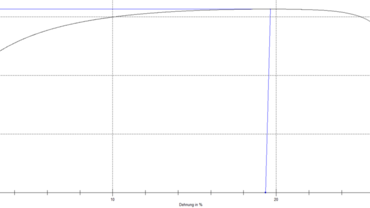r-Value Determination to ISO 10113
In addition to the offset yield, tensile strength, plastic extension, strain at break and the hardening exponent (n-value), the r-value, or more accurately, the vertical anisotropy is one of the typical characteristic values determined with a tensile test. All of these values are used for the characterization of metals and are determined in the areas of research & development, as well as for quality and acceptance tests. Related standards include ISO 10113, ASTM E517, and JIS Z2254.
What is the r-value? Significance ISO 10113 Examples Video Test equipment Downloads
What is the r-value to ISO 10113?
"The r-value is the “ratio of the true plastic width strain to the true plastic thickness strain” in a metal specimen that has been subjected to uniaxial tensile stress (definition from DIN EN ISO 10113).
To calculate the r-value, one would therefore need the measurement of the true plastic width- and thickness-strain during uniform elongation. However, since it is much easier to measure the change in length than the change in thickness, the standard is based on the model of constant volume in the range up to maximum force Ag (uniform elongation). If we assume that the volume is constant up to the plastic extensometerr- strain at maximum force Ag, we can replace the change in thickness with the change in length to determine the r-value.
Meaning of the r-value
If the r-value is 1, then we are looking at an isotropic material in which the deformation in terms of width and thickness changes to the same extent. If the value is greater than 1, we have a greater deformation in width. If the value is smaller than 1, we have a greater deformation in thickness.
Procedures and methods to ISO 10113
The ISO 10113 standard also defines three procedures and two methods for determination of the r-value.
Three procedures: In the automatic procedure, both the extension as well as change in width are measured with an extensometer. In addition, there is a semi-automatic procedure, where only the extension is measured with an extensometer, and the manual procedure where both the change in width and the extension are measured manually.
For the manual and semi-automatic procedures, the r-value is determined according to the single point method. Here, the r-value is determined at a certain degree of plastic stretch (e.g., through value determination at 2% and 5% plastic elongation).
The automatic procedure additionally provides the option of the regression method, which covers a course of development, that is, a full strain range. The data obtained from the true plastic longitudinal strain and true plastic width strain in a specified strain range is used to determine the slope.
The regression method is recommended as it provides more reliable r-values because it is averaged over a complete range and not just a snapshot, as is the case with the single point method (where determination is usually based on 2 or 5% plastic elongation).
Changes to ISO 10113: Evaluation of the entire gauge length
Up until 2020, determination of the r-value to ISO 10113 was based solely on the assumption that a metal material showed no taper within the parallel length, in the range up to uniform extension Ag. Based on this, the width was partially determined at the center of the specimen and it is assumed that the value applies to the full gauge length. However, in actuality, tapering already occurs during uniform extension, at a greater or lesser extent depending on the material. For materials with an r-value greater than 1, the behavior is clearly measurable. This has been confirmed by different studies.
This means that in order to achieve more realistic measured values, the r-value should be determined over the entire gauge length, since it then includes the tapering of the material.
For this reason, an amendment to the ISO 10113 standard has been in place since August 2020.
Change of standard ISO 10113 (2020-08) for higher reproducibility of r-values
Since the 2020 edition, ISO 10113 (2020-08) recommends the use of “extensometers for measurement of the instantaneous width reduction which are able to measure the change in width in multiple locations ideally evenly distributed across the entire gauge length.”
With this change of standard, realistic specimen results shall be determined and the reproducibility shall be increased. In addition, the method is easier to understand, since the same specimen volume is used for change in width and extension.
ZwickRoell offers the videoXtens T-160 HP specifically for this recommendation of the standard. It measures over 10 measurement axes, equally distributed over the entire measurement range. It not only produces realistic r-values to ISO 10113, but also precise, highly accurate values, since it was specially designed for this test.
Examples of r-values of various materials to ISO 10113
| Steel | rm-value | ∆r-value |
|---|---|---|
| Deep drawing steel DC04 | 1.85 | 0.70 |
| IF steel DC06 | 2.15 | 0.55 |
| Isotropic steel H250G1 | 1.05 | 0.00 |
| TRIP steel TRIP700 | 0.85 | -0.02 |
| Dual-phase steel H300X | 0.95 | -0.10 |
| Stainless steel X5CrNi18-10 | 1.00 | -0.30 |
| Aluminum AlMg5Mn (soft) | 0.66 | -0.21 |
| Aluminum AlSi1,2Mg0,4 (T4) | 0.64 | 0.20 |
| Copper Cu | 0.80 - 0.95 | |
| Bronze CuSn | 1.00 | |
| Brass CuZn37 soft | 0.91 | -0.03 |



